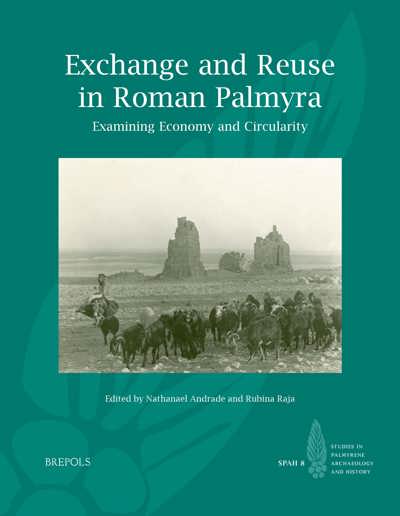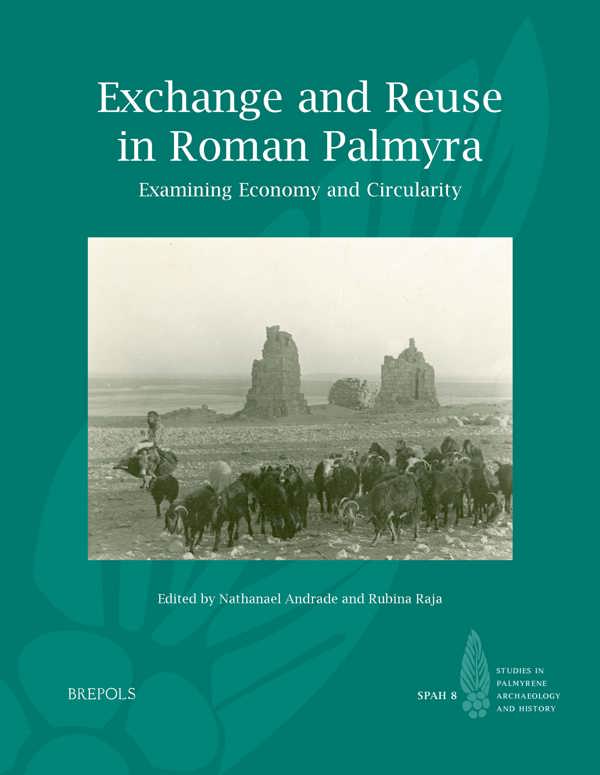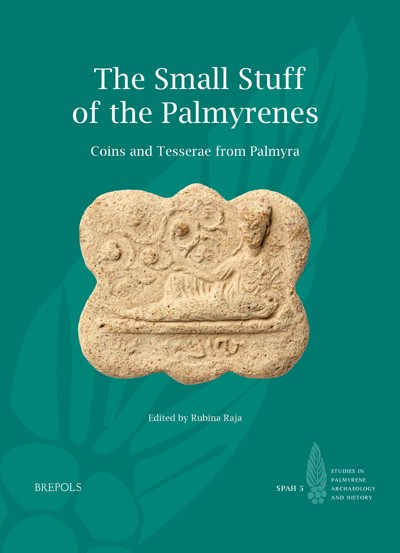
Exchange and Reuse in Roman Palmyra
Examining Economy and Circularity
Nathanael Andrade, Rubina Raja (eds)
- Pages: x + 132 p.
- Size:216 x 280 mm
- Illustrations:56 b/w, 15 col., 9 tables b/w., 1 maps b/w
- Language(s):English
- Publication Year:2023
- € 75,00 EXCL. VAT RETAIL PRICE
- ISBN: 978-2-503-60342-1
- Paperback
- Available
- € 75,00 EXCL. VAT RETAIL PRICE
- ISBN: 978-2-503-60343-8
- E-book
- Available
“Overall, Exchange and Reuse in Roman Palmyra achieves its goal of providing new avenues to think about and discuss the economy of Palmyra, moving away from the traditional discussions that focus on the evidence for the long-distance caravan trade route and tax tariff. While the evidence for these more traditional routes is far more explicit than the evidence for these new avenues, this speaks to the need for these new approaches to consider the less direct evidence. The contributions within this volume do just that and have shown a path forward for future discussions of the Palmyrene economy.” (Lila Knight, in Bryn Mawr Classical Review, 2024.02.35)
« Stimulant par sa thématique et par l’actualité du propos, ce volume éclaire d’un jour nouveau l’économie palmyrénienne en mettant en valeur des volets méconnus de la documentation disponible et en portant un regard différent sur les vestiges matériels et les textes. (...) Au-delà de son intérêt pour Palmyre et ses alentours, cette étude de cas parfois expérimentale nourrit la réflexion sur la gestion des ressources dans le monde romain dans son ensemble. Démontrant la complexité de ces enjeux, elle incite à approfondir leur analyse, ouvrant ainsi une voie encore inexplorée dans la recherche sur les rouages des systèmes économiques antiques. » (Hélène Fragaki, dans Revue archéologique, 2025/1, p. 225)
Nathanael Andrade is a Professor in the Department of History at Binghamton University, SUNY. He has authored many publications on the Roman Near East and the Roman Empire’s connections with the societies of Asia.
Rubina Raja is professor of Classical Archaeology and centre director of Centre for Urban Network Evolutions, Aarhus University. She heads several collective research projects focussing on Palmyra, among these the Circular Economy and Urban Sustainability project and has published widely on Palmyra and the Near East.
How did ancient cities like Palmyra survive? How did their people produce and manage the resources required for both their short- and long-term needs? Were their methods circular or wasteful? What materials did they reuse, and how? What form did their routine exchanges take? The material culture of Palmyra offers unique potential for addressing these questions in a concrete way. While the city is most famous for its long-distance commerce, a century of excavations at the site, together with a series of recent print publications and digital enterprises, have provided scholars with unprecedented amounts of material objects, among them inscriptions, statues, tesserae, coins, glass and metal finds, textiles, and other objects, all of which shed new light on Palmyra’s economy and how its inhabitants consumed, maintained, exchanged, or reused key resources.
Drawing together contributions from leading researchers on ancient Palmyra, this volume explores various dimensions of the city’s economy from fresh angles. The chapters gathered here feature new methodologies for determining the size of Palmyra’s population and for understanding the nature of coins in local exchanges, offer reassessments of the Palmyrene institutions that underpinned economic exchange, examine how Palmyrenes used and reused materials, and consider the forms of exchange and reuse that governed the building activity of Palmyrenes after the city’s Roman heyday and within areas of Egypt.
List of Illustrations
1. Economy and Circularity at Roman Palmyra: Reconsidering Aspects of the Ancient Economy on the Basis of Single-Site Analysis
Nathanael Andrade and Rubina Raja
2. Modelling an Urban Hinterland: The Case of Roman Palmyra
Joan Campmany Jiménez, Iza Romanowska, Rubina Raja, and Eivind Heldaas Seland
3. Circuits of Exchange: Palmyrene Coins and Roman Monetary Plurality
Kevin Butcher
4. Palmyrene Temples: Economic Institutions
Aleksandra Kubiak-Schneider
5. Circular Economy in Palmyra in the Light of Sale and Reuse of Funerary Spaces
Eleonora Cussini
6. Recarving of Palmyrene Funerary Portraits
Julia Steding
7. The Jewellery of the Women of Palmyra: Inheritance and Reuse
Olympia Bobou
8. Textile Economy of Roman Palmyra
Marta Żuchowska
9. A Matter of Size: A Dimensional Approach to the Study of Reused Inscriptions and Sculptures from the Sanctuary of Baalshamin at Palmyra
Emanuele E. Intagliata
10. The Palmyrene Diaspora in Egypt: Dependency, Sustainability, and Reuse
Matthew Adam Cobb
Index




